Every coach has a list of their team somewhere, and they don’t want to have to enter all of that information again, do they? OnePlaybook makes it easy to add your entire team all at once so you don’t have to sit there entering each individual’s information into our playbook software. Let’s see how it works.
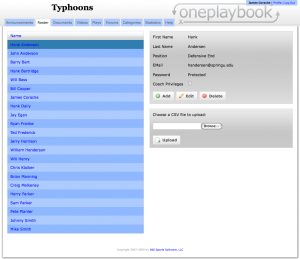
Here is a normal OnePlaybook's team's roster. Notice on the right hand side, the second gray area reads "Choose a CSV file to upload."
First, a coach just has to log in and go to the Roster page. You can see here that there is a section towards the bottom right that reads “Choose a CSV file to upload:” with a Browse button.
Well, what is a CSV file? That’s the abbreviation for Comma-Seperated Values, and can also be called a Comma Delimited File. Essentially it is a spreadsheet where instead of lines showing the different rows and columns, commas do that instead.
So, let’s fire up Excel (or your favorite spreadsheet application).
I’ve created a simple spreadsheet with two entries as an example. The colums are for first name, last name, position, email and password, just like when a coach wants to enter a single player’s or coaches’ information.
Notice in my spreadsheet that even though those are clearly what each column is for, I do not have labels at the top for those columns. Otherwise, I would end up with a player called “First Name Last Name” play at “Position” and have an email of “Email.”
Now, I am going to select “File” then “Save As…”
Depending on the program you are using, it may appear slightly differently, but you are looking for a drop-down that will be labeled something like “Format.”
Pressing on that will give you a lot of options and you want to select CSV or Comma Delimited.
After saving, you may be asked a few questions depending on your software. All you have to do is hit Ok or Yes to get through those.
We’ll go back to our team’s OnePlaybook Roster page now. We are going to hit Browse and find where we saved our CSV file. Just select it and press Open and we’ll come back to the Roster page.
The last step is to hit the Upload button below. After a few seconds, our file will upload and our team will be added.
All of the new coaches and players will be added and sent a notification email.
Our player and coach have been added quickly and easily so they can immediately start using our online playbook software. One thing to notice is that every player or coach is initially added as a player, so you will need to quickly edit coaches and give them coach priveleges on the Roster page.
The last thing to realize is that there are a lot of different spreadsheet programs available, so saving a CSV file might be slightly different based on your application and version. If you have problems, please contact us or use the comments section below and I’d be happy to work things through with you.
Want to make sure that everyone is watching your team’s videos? Or looking at your new plays?
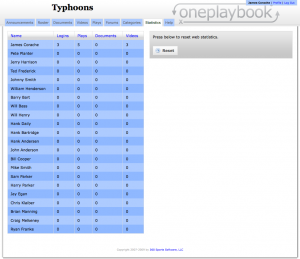
Using OnePlaybook web statistics, a coach can see who is using his online playbook and keep his players accountable.
How do you make sure that everyone is keeping up to date on your playbook? It’s simple with OnePlaybook’s web statistics. It’s a page only a coach can see and means he or she can keep track of who is logging in how often, and how may videos, documents and plays they are looking at. While you can never be sure that a player is looking at a handout, you can always be sure that they are looking at your online playbook.
To check your team’s web statistics, just go to the second to last tab on the right named Statistics. There you will see a list of all of your players and coaches as well how much they use your playbook software. By pressing on Logins, Plays, Documents or Videos, you can also sort by who is using your playbook the most and the least. The first click organizes by who has the most of that item, and the second click organizes by who has the least. Now your players are really accountable!
Though OnePlaybook has been developed for many sports and this tutorial applies to many different sports’ plays and playbooks, this is going to be a walk through on how to use OnePlaybook’s play drawing feature.
When a coach or a player clicks on the Plays tab, they are brought to a page that lists all of their plays drawn in their online playbook.
On the left is the name of each play, and when you click on a name, you select a play and information about that play, like who drew it and when, displays at the top right.
In addition, there are sections below for browsing based on categories, as well as placing plays in categories.
At the bottom right, there are four buttons, Offensive Plays, Defensive Plays, Offensive Snips and Defensive Snips. Snips save a coach time creating his playbook be reusing key parts of the play.
When we press on the Offensive Plays button, we go to a page where we have fewer plays listed because they are only the plays in the offensive playbook. This allows offensive coaches and defensive coaches the ability to easily find their information.
When we press on the Add Play button at the bottom right, we come to the editor page.
We come to a blank editor page where we have a lot of tools a coach can work with on his or her playbook. We’ll talk about each tool we use as we use it, and we’ll cover other tools at another time.
First, we’re going to name the play at the top left. We’re going to make this one pretty generic, Tutorial Play for our playbook software tutorials. Since we’re creating a football play for a football playbook, we’re going to use a part of a football field to draw on. All of the techniques here would work for a football playbook, or a basketball playbook, or any other sport’s playbook.
We’re going to add a player first by pressing on the third button, the oval and then pressing on our football field.
Now that that player is there, we’re going to want a smaller oval than that.
Notice how there is a new oval and box on the right below the gray area? That’s for our new player, and we can change his shape by pressing on the picture of his shape.
After clicking on the symbol, a new group of symbols appear and we can press on one of those and our player’s shape changes. This way a coach has a variety of symbols and shapes to use in his playbook.
Now, let’s do that with eleven more football players and draw a full football formation. Once they have been added, if they are not in the right place, we can use the Select button above the field all the way on the left. It has an arrow pointing up and to the left, like a cursor.
Once we press on it, we can press on players and drag them to where we want them in our play.
Once we draw that full formation and all of our players are in the right place, we now have almost everything we need to finish a basic play for our football playbook.
However, we also want to differentiate those players beyond having them be the same simple ovals. To do that, we can write one or two letters in the boxes at the right, and it will add those letters to the appropriate player on the field.
We’ll do that to a few players and then get to the final part of the play, the lines!
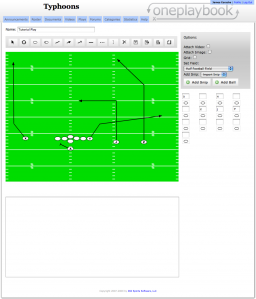
Lines can show whatever a coach wants them to show, in this case, it's where the players should move.
There are solid lines, dashed lines, lines with arrows at the end and lines with flat pieces at the end, usually for blocks or picks, but again, a coach has full control over what anything means.
When you draw a line, you press in one place and drag to another. Once a line has been drawn, you can select it with the Select button, just like a player, and drag it, or drag the ends to re-size it. In addition, you can select it and then press on what kind of line you want it to be. So, if you drew a regular solid line, but wanted to change it to an arrow, you can select it and then press on the arrow line button at the top.
Finally, to make it even easier for players to understand our plays and our playbook, we’re going to add some text at the bottom.
In this case, it’s some very simple text, but coaches can write whatever they want to make their online playbook simpler and easier to use.
There are many more options, as you can see in the images, but we want a simple football play, nothing more. In later sports software tutorials, we’ll be doing things with video, images and text on the field, but those are things for later.
Of course though, we want to save our play! There is a disk button at the top to save the play. In addition, there is a disk with a plus if you’re editing a play and you don’t want to overwrite the old play.
We’ll go with the save button now and then head back to the plays page. From there, we’ll press on the plays name in the list on the left. It’s now been immediately added to all of the old plays in our playbook.
We can then see information on the right like when the play was created and by who. We’re going to press on the button with the plays name so that we can see our football play just like our football players see it.
And there it is, a newly created football play has been added to our online football playbook, quickly and easily.
Again, all of these techniques work for any sport, but in this example, we were a football coach creating a football play.
You can use the form below to ask any questions you may have.
In addition, everything is editable and nothing is permanent. A coach can play around with the tools and change the play, and always delete it later.
Finally, there are more tutorials to come about our play editor and the tools available for a coach.
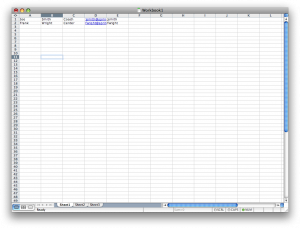
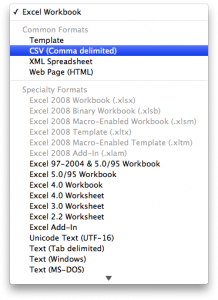
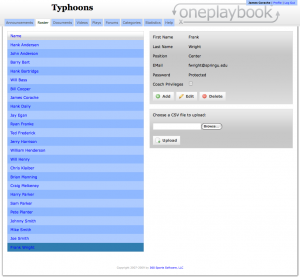
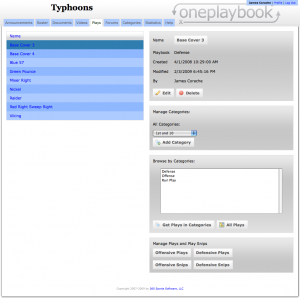
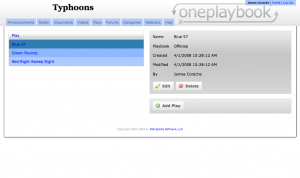
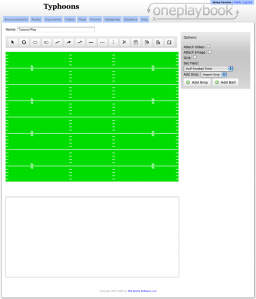
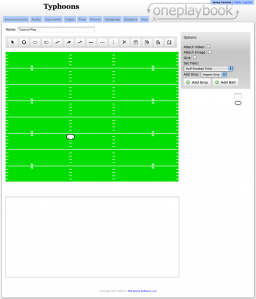
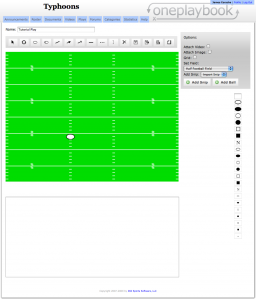
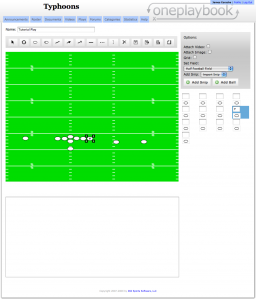
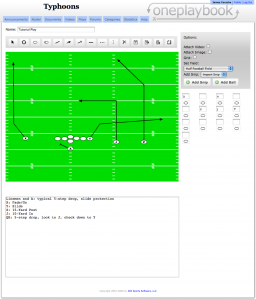
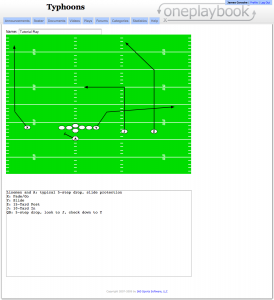
 Subscribe in an RSS Reader
Subscribe in an RSS Reader
 Subscribe by Email
Subscribe by Email